Labs and Analytical Capabilities
The WCU Chemistry Department houses a wide range of analytical instruments that enable us to perform precise analytical measurements for various applications. We use all these instruments for both classroom teaching and research purposes. We believe that hands-on experiences on state-of-the-art equipment are crucial to retaining theoretical concepts and preparing students for future careers in all disciplines of chemistry. We provide comprehensive training and guidance to all students to ensure they are competent in using the analytical equipment for their laboratory courses. Our undergraduate researchers are trained to become proficient in every step of the analytical process, helping them to independently design experiments and utilize analytical instruments.
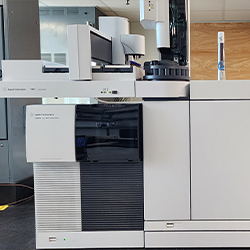

Separation and Identification
From simple sample extraction techniques to complex instrumental separation techniques, the study of mixtures is integral to several chemistry disciplines.
Students in chemistry courses practice separations using separatory funnels, distillation, crystallization, thin layer chromatography (TLC), gel size exclusion, electrophoresis, and liquid and gas chromatography.
Our instrumentation includes multiple gas chromatographs with flame ionization detectors and mass spectrometers (GC-FID, GC-MS, GC-QQQ) liquid chromatographs with UV detectors and interfaced to mass spectrometers (HPLC, LC-MS-MS), flash chromatography, gel electrophoresis, capillary electrophoresis (CE), Supercritical fluid chromatography (SFC), and TLC-MS.
List of equipment: CombiFlash Rf 4X Automated Flash Chromatography System, Agilent 7890 GC with 7000D triple quadrupole MS, Advion CMS TLC-MS, Thermo Scientific Single Quad ISQ GCMS, Agilent 1260 Infinity SFC with Flexible Cube, Agilent 6460 LC-triple quadrupole MS, Agilent 5795C GC-MS, Agilent Infinity 1200 HPLC

Separation and Identification
From simple sample extraction techniques to complex instrumental separation techniques, the study of mixtures is integral to several chemistry disciplines.
Students in chemistry courses practice separations using separatory funnels, distillation, crystallization, thin layer chromatography (TLC), gel size exclusion, electrophoresis, and liquid and gas chromatography.
Our instrumentation includes multiple gas chromatographs with flame ionization detectors and mass spectrometers (GC-FID, GC-MS, GC-QQQ) liquid chromatographs with UV detectors and interfaced to mass spectrometers (HPLC, LC-MS-MS), flash chromatography, gel electrophoresis, capillary electrophoresis (CE), Supercritical fluid chromatography (SFC), and TLC-MS.
List of equipment: CombiFlash Rf 4X Automated Flash Chromatography System, Agilent 7890 GC with 7000D triple quadrupole MS, Advion CMS TLC-MS, Thermo Scientific Single Quad ISQ GCMS, Agilent 1260 Infinity SFC with Flexible Cube, Agilent 6460 LC-triple quadrupole MS, Agilent 5795C GC-MS, Agilent Infinity 1200 HPLC
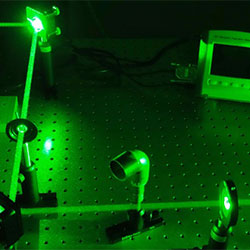

Photons, Spectroscopy, and Structure Determination
The study of the interaction of light and matter is pivotal to the characterization of materials properties, dynamics, and kinetics. These interactions are also important for initiating photochemical and laser-mediated processes.
One of the most fundamental aspects of chemistry is determining what atoms are bound to each other in molecules and compounds. This aspect of structure determination is performed with an array of techniques. X-ray powder diffraction (XRD)is a powerful technique for determining the structure of solids as well as their chemical composition. Mass spectrometry (MS) is an essential tool for characterizing molecules as is nuclear magnetic resonance (NMR).
Our instrumentation includes research-grade UV-Vis spectrometers with attachments for various experiments, a fluorometer with a solid sample holder and a thermostat, research-grade Fourier transform infrared (FTIR) spectrometers and laboratory IR spectrometers, Raman spectrometer. We have elemental analysis capabilities with an inductively coupled plasma- optical emission spectrometer (ICP-OES) and X-ray fluorescence (XRF), X-ray diffractometers (XRD), Research grade MHz nuclear magnetic resonance spectrometers (NMR) and benchtop NMR, Mass spectrometers (MS) interfaced to GC and LC instruments and standalone MS
List of equipment: Nicolet iS10 FT-Raman module, Nicolet iS50 FTIR, Nicolet iN10 FTIR microscope, Agilent Inductively Coupled Plasma Optical Emission Spectrometer, Thermo Fisher iS5 FTIRs, Cary-60 UV-vis spectrophotometer, ThermoScientific Nanodrop UV-Vis spectrophotometer, Shimadzu RF-6000 spectrofluorometer, Fluorescence Cary Eclipse System, UV-VIS Cary 100/300 Spectrometer, other UV-VIS spectrophotometers, NMR Spectrometer 400, NMR Spectrometer 90, NMR Spectrometer 60
Our laser capabilities include Quanta Ray INDI-HG-205 Nd:YAG nanosecond pulsed laser with second and third harmonic generation.

Photons, Spectroscopy, and Structure Determination
The study of the interaction of light and matter is pivotal to the characterization of materials properties, dynamics, and kinetics. These interactions are also important for initiating photochemical and laser-mediated processes.
One of the most fundamental aspects of chemistry is determining what atoms are bound to each other in molecules and compounds. This aspect of structure determination is performed with an array of techniques. X-ray powder diffraction (XRD)is a powerful technique for determining the structure of solids as well as their chemical composition. Mass spectrometry (MS) is an essential tool for characterizing molecules as is nuclear magnetic resonance (NMR).
Our instrumentation includes research-grade UV-Vis spectrometers with attachments for various experiments, a fluorometer with a solid sample holder and a thermostat, research-grade Fourier transform infrared (FTIR) spectrometers and laboratory IR spectrometers, Raman spectrometer. We have elemental analysis capabilities with an inductively coupled plasma- optical emission spectrometer (ICP-OES) and X-ray fluorescence (XRF), X-ray diffractometers (XRD), Research grade MHz nuclear magnetic resonance spectrometers (NMR) and benchtop NMR, Mass spectrometers (MS) interfaced to GC and LC instruments and standalone MS
List of equipment: Nicolet iS10 FT-Raman module, Nicolet iS50 FTIR, Nicolet iN10 FTIR microscope, Agilent Inductively Coupled Plasma Optical Emission Spectrometer, Thermo Fisher iS5 FTIRs, Cary-60 UV-vis spectrophotometer, ThermoScientific Nanodrop UV-Vis spectrophotometer, Shimadzu RF-6000 spectrofluorometer, Fluorescence Cary Eclipse System, UV-VIS Cary 100/300 Spectrometer, other UV-VIS spectrophotometers, NMR Spectrometer 400, NMR Spectrometer 90, NMR Spectrometer 60
Our laser capabilities include Quanta Ray INDI-HG-205 Nd:YAG nanosecond pulsed laser with second and third harmonic generation.
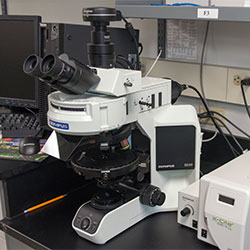

Optical Microscopy
Optical and infrared (IR) microscopy are essential for forensic analysis and materials characterization.
Our instrumentation includes: Several stereomicroscopes and polarized light microscopes (PLM), digital microscopes, epifluorescence microscope, an infrared microscope, a comparison PLM
Other optical microscopy facilities are available in the Center for Microanalysis and Imaging Research and Training (CMIRT). List of equipment: Leica DM750P PLMs, Leica EZ4 Stereomicroscopes, Leice DM 750P comparison bridge, Olympus BX43F epifluorescence PLM, Nicolet iN10 FTIR microscope

Optical Microscopy
Optical and infrared (IR) microscopy are essential for forensic analysis and materials characterization.
Our instrumentation includes: Several stereomicroscopes and polarized light microscopes (PLM), digital microscopes, epifluorescence microscope, an infrared microscope, a comparison PLM
Other optical microscopy facilities are available in the Center for Microanalysis and Imaging Research and Training (CMIRT). List of equipment: Leica DM750P PLMs, Leica EZ4 Stereomicroscopes, Leice DM 750P comparison bridge, Olympus BX43F epifluorescence PLM, Nicolet iN10 FTIR microscope
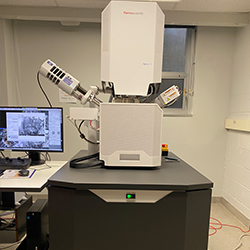

Electron Microscopy
Electron microscopy facilities are housed within the Center for Microanalysis and Imaging Research and Training(CMIRT). Electron microscopy allows us to perform elemental and structural analysis with a spatial resolution far below that of optical microscopy. Objects as small as 30–50 nm can be observed with our scanning electron microscope (SEM) and less than 1 nm with our transmission electron microscope (TEM).
Our instrumentation includes: Scanning electron microscope (SEM), Energy dispersive X-ray spectrometer (EDS), Transmission electron microscope (TEM)

Electron Microscopy
Electron microscopy facilities are housed within the Center for Microanalysis and Imaging Research and Training(CMIRT). Electron microscopy allows us to perform elemental and structural analysis with a spatial resolution far below that of optical microscopy. Objects as small as 30–50 nm can be observed with our scanning electron microscope (SEM) and less than 1 nm with our transmission electron microscope (TEM).
Our instrumentation includes: Scanning electron microscope (SEM), Energy dispersive X-ray spectrometer (EDS), Transmission electron microscope (TEM)
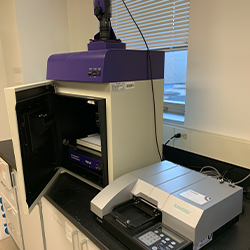

Other Instrumental Analysis
A wide variety of other instrumentation is also available in the department.
These include a critical point drier, polymerase chain reaction (PCR) analysis, differential scanning calorimeter, Randox microplate reader, and an ion mobility spectrometer

Other Instrumental Analysis
A wide variety of other instrumentation is also available in the department.
These include a critical point drier, polymerase chain reaction (PCR) analysis, differential scanning calorimeter, Randox microplate reader, and an ion mobility spectrometer
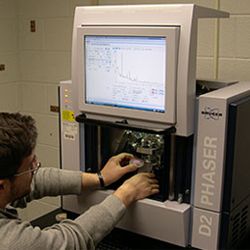

CMIRT & Other Research Facilities
Center for Microanalysis and Imaging Research and Training (CMIRT)

CMIRT & Other Research Facilities
Center for Microanalysis and Imaging Research and Training (CMIRT)
